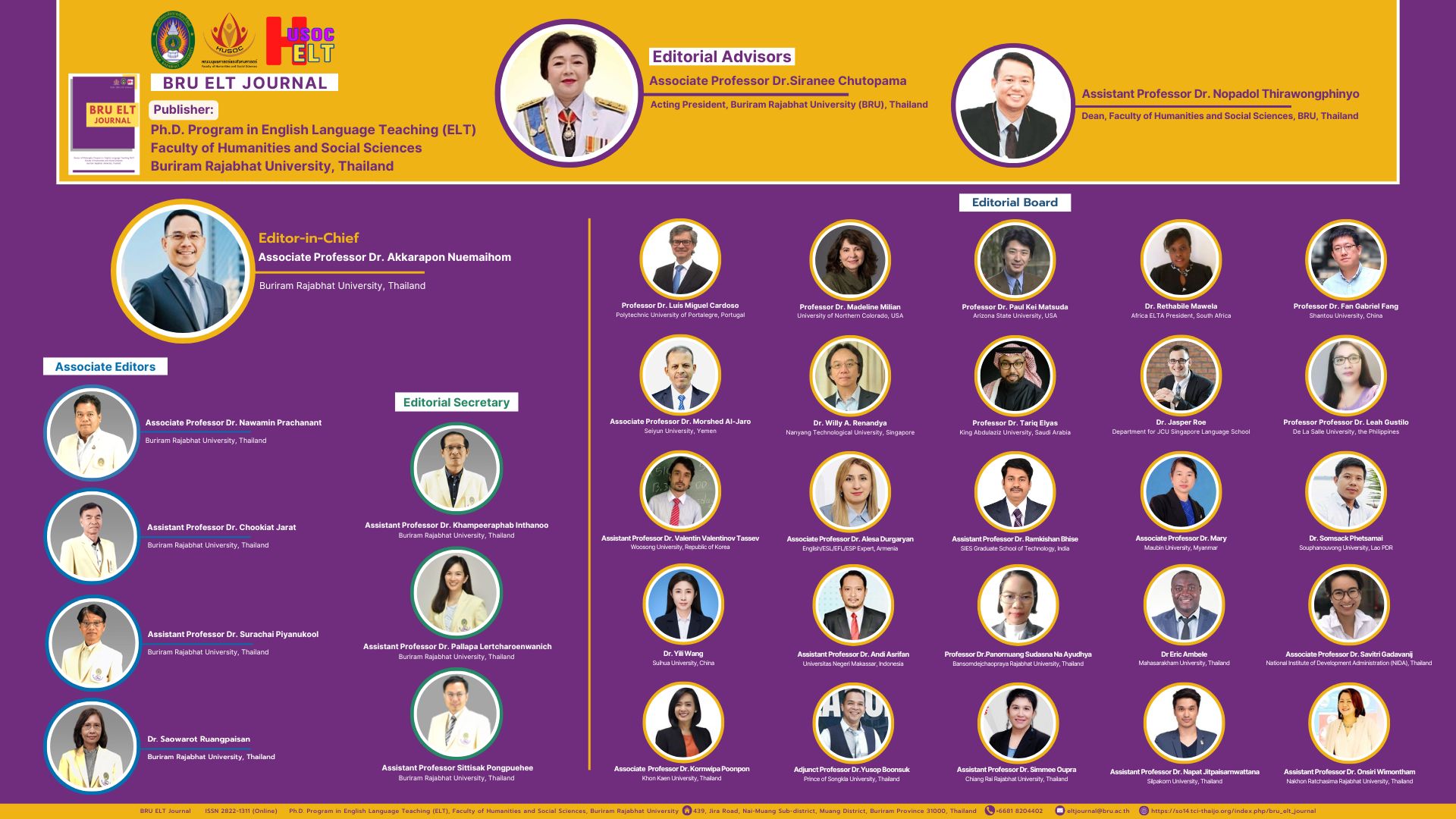English Conversational Skills of Grade 11 Students as Predictors of Their Performance in Oral Communication
DOI:
https://doi.org/10.14456/bej.2023.11Keywords:
conversational skills, oral communication, predictorsAbstract
Conversation is embedded in speaking activities and performance tasks in any subject area. However, students struggle to engage in conversations, especially if the English language is used as the medium of instruction, affecting their performances. This study examined the Grade 11 students' conversational skills in terms of attentiveness, composure, coordination, expressiveness, and grammar as predictors of their performance in oral communication. A quantitative descriptive correlational design was used. Twenty-seven Grade 11 students were chosen via the purposeful sampling method. In data collection, the researcher video-recorded a conversation between each student and the researcher. The conversations were assessed by the researcher and interrater using the Conversational Skills Rating Scale. The semester grade of the students’ oral communication performance was also taken and analyzed through descriptive statistics. A regression analysis was done to determine if the participants’ conversational skills predicted their performance in oral communication. Data reveal that participants’ conversational skills were generally good which implies that students have sufficient conversational skills but still need to be developed. Moreover, participants’ conversational skills significantly influence their oral communication performance and among the five skills, expressiveness stands out as having a significant influence on their performance in oral communication. It is recommended that teachers implement engaging speaking activities in the teaching of oral communication.
References
Aditya, M. Y., & Chairuddin, C. (2020). The use of the six english tenses in students’ daily conversation. E-Structural (English Studies on Translation, Culture, Literature, and Linguistics), 3(02), 157-167.
Akkakoson, S. (2016). Speaking anxiety in English conversation classrooms among Thai students. Malaysian Journal of Learning and Instruction (13), 63-82. https://doi.org/10.32890/mjli2016.13.1.4
Andes, C.P. (2019). Oral communication proficiency of the senior high school students in the division of Sorsogon. Ascendens Asia Journal of Multidisciplinary Research Abstracts Vol. 3. No. 2F.
Cabigon, M. (2015). state of English in the Philippines: Should we be concerned? British Council – Philippines.
Cestero, A.M. (2017). The teaching of conversation. AM Cestero and I. Penadés (eds.), ELE Teacher's Manual, Alcalá de Henares, University of Alcalá, pp.1013-1049.
Chen, L.L. (2016). Laughter, smiling and their pragmatic/interpersonal functions: An interactional linguistic account. Concentric: Studies in Linguistics. 42.2 (November 2016): 135-168. https://doi.org/10.6241/concentric.ling.42.2.05
Choi, J., & Lee, Y. (2015). Contingency and informativeness of topic maintenance in children with high-functioning autism spectrum disorders. Communication Sciences & Disorders (20), 413–423.
Chowdhury, S. A., Morena. D., & Giuseppe, R. (2017). Functions of silences towards information flown in spoken conversation. Proceedings of the Workshop on Speech-Centric Natural Language Processing. Denmark: for Computational Linguistics.
Faradiba, A., Hidayati, I. N., & Sofyan, D. (2018). Students’error in constructing complex sentences. Journal of English Teaching and Linguistics Studies (JET Li), 1(1), 7-15.
Giles, H., & Ogay, T. (2007). Communication accommodation theory. In B. B. Whaley & W. Samter (Eds.), Explaining communication: Contemporary theories and exemplars (pp. 293-310). Mahwah, NJ: Lawrence Erlbaum.
Harris, A.S. (2019). An analysis of students’ speaking anxiety on speaking performance of the third semester of English language education at FKIP UIR Pekanbaru, Thesis.
Heo, H., & Lee, Y. (2012). Conversational turn-taking and topic manipulation skills in conversations of school-age low-achievers in language learning. Korean Journal of Communication Disorders (17), 66–78.
Hidayat, S.N. (2015). An analysis of students‟ body language responses to teacher talk at speaking class in UIN Alauddin Makassar.
Hulu, F. (2018). The description of hands shake and voice trembles in conducting class presentation by the 4th semester students at Putera Batam University." Jurnal Basis, 5(1), 1-12. https://doi.org/10.33884/basisupb.v5i1.330
Hymes, D. H. (1972). On communicative competence. In Pride, J. B., & Holmes, J. (Eds.), Sociolinguistics, 269-293.
Lestary, A., Krismanti, N., & Hermaniar, Y. (2017). Interruptions and silences in conversations: A turn-taking analysis. Journal of Linguistics and Education, 7(2), 53-64.
Mahmud, M.M. (2014). Communication aptitude and academic success. https://doi.org/10.1016/j.sbspro.2014.04.230
Matsumoto, D., & Hwang, H. S. (2013). Body and gestures (pp. 75-96). Sage.
Mofarah, A.A. (2019). Difficulties facing students in English language conversation. International Research in Higher Education, 4(3). https://doi.org/10.5430/irhe.v4n3p51
Palmero, G. M. G. (2019). Oral communication proficiency and learning engagement of grade 11 students in English. Global Scientific Journals, 7(8), Online: ISSN 2320-9186.
Piggin, G. (2012). What are our tools really made of? A critical assessment of recent models of language proficiency. Polyglossia, 22, 79-87.
Protacio, A.V. (2021). Improving students’ articulatory fluency in English through speech smart module. International Journal of English Literature and Social Sciences, 6(3). https://doi.org/10.22161/ijels
Rahim, A., & Quraishi, P. (2019). Investigating EFL students’ poor speaking skills at Kandahar University. American International Journal of Education and Linguistics Research, 2(2), 1-9. https://doi.org/10.46545/aijelr.v2i2.183
Rivero Cruz, L., Tardo Fernández, Y., & Rey Rivas, P. C. (2020). Conversational competence in the teaching-learning process of foreign languages: Gnoseological and didactic references. Revista Conrado, 16(76), 287-294.
Sathik, M., & Jonathan, S. G. (2013). Effect of facial expressions on student’s comprehension recognition in virtual educational environments. Springerplus 2(1), 1–9. .
Shah, A. A., Syeda, Z.F., & Naseer, S. (2020). University students’ communication skills as a determinant of academic achievement. Sir Syed Journal of Education & Social Research, 3(2), 107-114. https://doi.org/10.36902/sjesr-vol3-iss2-2020(107-114)
Spitzberg, B. H., & Adams III, T. W. (2007). CSRS: The conversational skills rating scale-An instructional assessment of interpersonal competence (NCA Diagnostic Series, (2nd ed.). Annandale, VA: National Communication Association.
Tafida, Amina G., & Okunade, Shittu K. (2016). Subject-verb agreement problem among English as secondary learners: A case of one hundred level undergraduates of Federal University of Technology, Minna. Journal of Education and General Studies, 2(2).
Xue, J., & Zuo, W. J. (2013). English dominance and its influence on international communication. Theory and Practice in Language Studie, (3), 2262-2266. https://doi.org/10.4304/tpls.3.12.2262-2266






